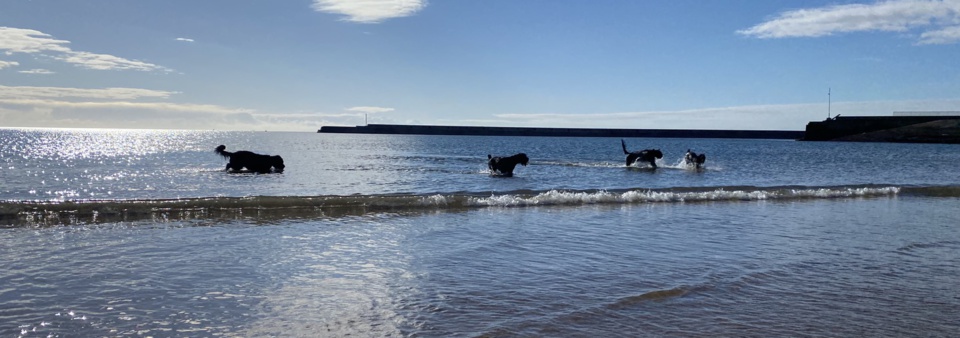
Punishing a Dog
So, what is punishment?
Punishment is the authoritative imposition of something undesirable or unpleasant upon an individual or group, in response to behaviour that an authority deems unacceptable or a violation of some norm. The unpleasant imposition may include a fine, penalty, or confinement, or be the removal or denial of something pleasant or desirable. The individual may be a person, or even an animal.
So now we know what a punishment is, how do we do it to a dog?
The term 'punishment' always invokes paroxysms of fear: 'What? You punish your dog!' As if I beat the dog! Now, remember our definition. Punishment can take many forms and be dependent on each individual dog and also be different in differing situation for the same dog.
All puppies trained through Crucially Canine are taught the word "no". This means "stop what you're doing and look at me". But how do you get a puppy to stop chewing the corner of the rug and the word "no" when they've never heard it before? Simple, we pair it with something nice when they do stop and look, or something horrid, such as a sqirt from a water pistol, if he doesn't look. You're now giving the puppy the opportunity to earn a treat and avoid a punishment. With consistency an 8 week old puppy will learn the "no" command, with respect to avoiding the water squirt, within 3 days. It is then up to you to make the word "no" a positive word with praise and treats for stopping the unwanted activity and looking at you.
Punishment, regardless of its form needs to be administered during the the unwanted activity or within 2 seconds of the dog not stopping once the "no" command has been issued. If this is not done the dog will be rewarded or punished for the wrong action.
With respect to the water pistol; this should never be on display. Hidden in a pocket would be best, and once used immediately hidden again. This is to overcome the problem of the dog only stopping because he sees the punishment coming. We want him to want to stop to the verbal command and earn that treat, not be scared whenever he sees a water pistol.
Once the "No" command is taught it can be applied to all scenarios throughout the dogs life as all it means is: stop what you're doing and look at me.
With older dogs the "No" command work will work equally well but may be complicated by the fact that the behaviour is 'in ground'. In this situation Cognitive Behaviour Therapy is required or you, the owner, need to look at your communication with the dog. Identify what your dog loves: food, ball, chew toy. Then exploit that love/desire to have that food/ball/chew toy. Be strict with yourself when you reward or remove that reward. This is clear repetitive communication.
The above strategy should work in probably 95% of cases. The remainder falls into 2 categories:
1) A behavioural issue: a dog with a huge drive/desire to continue an unwanted behaviour and the verbal cue is not enough of a deterrent to overcome the behaviour. In this scenario we should employ cognitive behavioural therapy.
2) Stimulus generalisation: the dog is unsure about what action follows which command and therefore 'cycles' through learned behaviours regardless of the command given.
Cognitive Behavioural Therapy is a psychotherapeutic approach that addresses maladaptive behaviours and cognitive processes and resolves through a number of goal orientated procedures.
If your dog is cycling through behaviours after a command you need to praise heavily when he gets it correct immediately after you issuing the command. If you issue a command such as lie down and the dog sits you should immediately turn your back and walk off, give the dog nothing, not even eye contact. Wait just 3-4 seconds and start again. This will develop clear incentivised communication and make you dog want to work for you.
